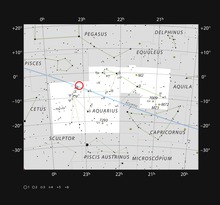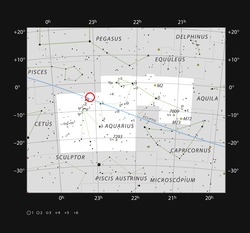TRAPPIST-1
ကိုဩဒိနိတ်: ![]() 23h 06m 29.383s, −05° 02′ 28.59″
23h 06m 29.383s, −05° 02′ 28.59″
| စောင့်ကြည့်ဒေတာ Epoch Equinox | |
|---|---|
| ကြယ်စုတန်း | ကုံ နက္ခတ်တာရာ |
| ညာဘက် နိမ့်ဆင်းမှု | 23° 06′ 29.283″[၂] |
| တိမ်းစောင်းမှု | –05° 02′ 28.59″[၂] |
| ပကတိ အရွယ်အစား (V) | 18.80 |
| ဂုဏ်သတ္တိ | |
| စတီလာ အမျိုးအစား | M8V[၃] M8.2V[note ၁] |
| V−R အရောင်ညွန်းကိန်း | 2.33 |
| R−I အရောင်ညွန်းကိန်း | 2.47 |
| နက္ခတ္တဗေဒ | |
| ဗဟိုခွာအား အလျင် (Rv) | −56.3 km/s |
| ပြောင်းလဲ တည်နေရာ (π) | 82.58 mas |
| အကွာအဝေး | 39.5 ± 1.3 ly (12.1 ± 0.4 pc) |
| ပကတိ အရွယ်အစား (MV) | 18.4 ± 0.1 |
| အသေးစိတ် | |
| ဒြပ်ထု | 0.08 ± 0.009 M☉ |
| ဒြပ်ထု | 83.8048 ± 9.428 MJup |
| အချင်းဝက် | 0.114 ± 0.006 R☉ |
| တောက်ပမှု (bolometric) | 0.000525±0.000036[၄] L☉ |
| တောက်ပမှု (visual, LV) | 0.00000373[note ၂] L☉ |
| မျက်နှာပြင် ဒြပ်ဆွဲအား(log g) | ~5.227[note ၃][၅] cgs |
| သက်ရောက်သည့် အပူချိန် | 2550 ± 55 K |
| သတ္တုကြွယ်ဝမှု | 0.04 ± 0.08 |
| စတီလာ လှည့်ပတ်မှု | 1.40 ± 0.05 days |
| လှည့်ပတ်အလျင် (v sin i) | 6 ± 2 km/s |
| စတီလာ သက်တမ်း | > ၁ Gyr |
| ကြယ် စာရင်း | |
2MASS J23062928-0502285, 2MASSI J2306292-050227, 2MASSW J2306292-050227, 2MUDC 12171 | |
| ရည်ညွန်း ဒေတာ | |
| SIMBAD | data |

TRAPPIST-1 ( 2MASS J23062928-0502285)[၆]သည် အင်မတန်အေးမြသော ကြယ်ပု ဖြစ်ပြီး[၄][၇] ကမ္ဘာမြေမှ အလင်းနှစ် ၃၉ (၁၂ Parsec) အကွာ ကုံ နက္ခတ်တာရာ၌ တည်ရှိသည်။[၈]
ဘယ်လ်ဂျီယမ်နိုင်ငံ Liège တက္ကသိုလ်မှ နက္ခတ္တပညာရှင် Michaël Gillon ဦးဆောင်သောအဖွဲ့သည်[၉] TRAPPIST (Transiting Planets and Planetesimals Small Telescope) တယ်လီစကုပ်ဖြင့် ယင်းကြယ်စနစ်အား လေ့လာခဲ့သည်။[၁၀] ထိုသို့လေ့လာရာ ကမ္ဘာမြေနှင့် ဆင်တူသော နေစကြဝဠာပြင်ပဂြိုဟ် ၃ လုံးကို တွေ့ရှိခဲ့သည်။[၇][၁၁] အဖွဲ့သားတို့သည် လေ့လာစောင့်ကြည့်မှုအား ၂၀၁၅ ခုနှစ် စက်တင်ဘာလမှ စတင်လုပ်ဆောင်ခဲ့ပြီး ၂၀၁၆ ခုနှစ် မေလတွင် တွေ့ရှိချက်များကို Nature ဂျာနယ်၌ ထုတ်ပြန်ခဲ့သည်။[၁၀][၁၂] ၂၀၁၇ ဖေဖော်ဝါရီ ၂၂ တွင် TRAPPIST-1 ကြယ်အနီးမှ နောက်ထပ်ဂြိုဟ် ၄ စင်းအား ရှာဖွေတွေ့ရှိသည်ဟု သတင်းထုတ်ပြန်ခဲ့သည်။ ယင်းနေစကြဝဠာပြင်ပ ဂြိုဟ်အားလုံးသည်လည်း သက်ရှိများရှင်သန်နိုင်သောဇုန်အတွင်း တည်ရှိနိုင်သည်ဟုဆိုသည်။[၁၃][၁၄] ၂၀၁၇ ဖေဖော်ဝါရီလအရ TRAPPIST-1 သည် ခြေရာခံမိသမျှ ဂြိုဟ်စနစ်များတွင် အစင်းရေ ၇ စင်းဖြင့် အများဆုံး စံချိန်တင်ခဲ့သည်။[၁၅][၁၆]
ရှာဖွေတွေ့ရှိမှု
[ပြင်ဆင်ရန်]ရှာဖွေရေးအဖွဲ့သားတို့သည် ၂၀၁၅ ခုနှစ် စက်တင်ဘာလမှ ဒီဇင်ဘာလအထိ ဆောင်ရွက်ခဲ့ပြီး ၂၀၁၆ မေလတွင် Nature ဂျာနယ်၌ ထုတ်ပြန်ခဲ့သည်။[၁၀][၁၇]
TRAPPIST-1 သည် TRAPPIST ဆိုသည့် တယ်လီစကုပ်မှ အမည်တပ်ခြင်းဖြစ်သည်။ [၁၈] ပထမဆုံးတွေ့ရှိသည့် ဂြိုဟ်များကိုမူ အင်္ဂလိပ် အက္ခရာ b မှ စတင်ကာ c အစရှိသည်ဖြင့် သတ်မှတ်သည်။[၁၉] TRAPPIST-1 အနားမှ ပထမဆုံး တွေ့ရှိခဲ့သည်ဂြိုဟ် ၃ စင်းကို b c d ဟု သတ်မှတ်ခဲ့သည်။ နောက်ထပ်တွေ့ရှိသည့် အသုတ်သည်လည်း e မှ h ဟုအမည်ပေးသည်။
စတီလာ ဂုဏ်သတ္တိများ
[ပြင်ဆင်ရန်]TRAPPIST-1 သည် အင်မတန်အေးမြသော ကြယ်ပုဖြစ်ကာ နေ၏ အချင်းဝက် ၁၁ ရာခိုင်နှုန်း၊ ထုထည်မှာ နေ၏ ၈ ရာခိုင်နှုန်းနီးပါး ရှိပြီး ဂျူပီတာဂြိုဟ်ထက် ၈၄ ဆ ပိုမိုကြီးမားသည်ဆိုသော်လည်း ဂျူပီတာအရွယ်အစားနှင့် ဆင်တူသည်။[၂၀][၄] အပူချိန်မှာ ၂၅၅၀ ကေလ်ဘင် ရှိပြီး သက်တမ်းအားဖြင့် ၅၀၀ မီလီယံနှစ် ရှိသည်။[၄] နှိုင်းယှဉ်ရသော် နေသည် ၄.၆ ဘီလီယံနှစ်ရှိပြီး[၂၁] အပူချိန်မှာ ၅၇၇၈ ကေလ်ဘင် ရှိသည်။[၂၂] ယင်း၏ ထုထည်ပိုင်ဆိုင်မှုအရ TRAPPIST-1 သည် ပင်မအစီစဉ်ရှိကြယ်အဖြစ် နောင်နှစ်ပေါင်း ၁၂ ထရီလီယံခန့် သက်တမ်းရှည်ကြာမည်ဖြစ်သည်။[၂၃] ကြယ်သည် သတ္တုကြွယ်ဝပြီး တောက်ပမှုမှာ နေ၏ ၀.၀၄ ရာခိုင်နှုန်း ဖြစ်ပြီး အများစုမှာ အနီအောက်ရောင်ခြည်လှိုင်းကို ထုတ်ပေးသည်။ ယင်းကြယ်အား ကမ္ဘာမြေမှ သာမန်မျက်စိဖြင့် မမြင်နိုင်ပေ။
ဂြိုဟ်စနစ်
[ပြင်ဆင်ရန်]၂၀၁၇ ဖေဖော်ဝါရီလတွင် ယင်းကြယ်၏ဂြိုဟ်စနစ်၌ အပူချိန်မျှတသော ဂြိုဟ် ၇ စင်းကို ရှာဖွေတွေ့ရှိခဲ့သည်ဟု ကြေညာခဲ့သည်။ TRAPPIST-1 ကြယ်စနစ်ရှိ b c e f g ဟူသောဂြိုဟ်တို့သည် ကမ္ဘာမြေနှင့်တူပြီး d h တို့သည် ကမ္ဘာနှင့် အင်္ဂါဂြိုဟ်အရွယ်အစား ရှိသည်။[၂၄] သုံးခုသည် (e, f နှင့် g) ဂိုးလ်ဒီလောဇုန်အတွင်း လှည့်ပတ်နေကြသည်။[၂၄][၂၅][၂၆][၂၇] အတွင်းပိုင်း ဂြိုဟ် ၆ လုံး၏ စုစုပေါင်းပမာဏသည် TRAPPIST-1 ကြယ်၏ ၀.၀၂ ရာခိုင်နှုန်းရှိသည်။[၂၄]
| အဖော် (ကြယ်မှ အစီစဉ်အတိုင်း) |
ထုထည် | ဆီမီးမေဂျာ ဝင်ရိုး (AU) |
ပတ်လမ်းကာလ (ရက်) |
ပတ်လမ်းဗဟိုကျမှု | နိမ့်ဆင်းမှု | အချင်းဝက်
|
|---|---|---|---|---|---|---|
| b | 0.85±0.72 M⊕ | 0.01111 | 1.51087081 ± 0.00000060 | < 0.081 | 89.65 ± 0.25° | 1.086 ± 0.035 R⊕ |
| c | 1.38±0.61 M⊕ | 0.01522 | 2.4218233 ± 0.0000017 | < 0.083 | 89.67 ± 0.17° | 1.056 ± 0.035 R⊕ |
| d | 0.41±0.27 M⊕ | 0.021 ± 0.006 | 4.049610 ± 0.000063 | < 0.070 | 89.75 ± 0.16° | 0.772 ± 0.030 R⊕ |
| e | 0.62±0.58 M⊕ | 0.028 | 6.099615 ± 0.000011 | < 0.085 | 89.86 ± 0.11° | 0.918 ± 0.039 R⊕ |
| f | 0.68±0.18 M⊕ | 0.037 | 9.206690 ± 0.000015 | < 0.063 | 89.680 ± 0.034° | 1.045 ± 0.038 R⊕ |
| g | 1.34±0.88 M⊕ | 0.045 | 12.35294 ± 0.00012 | < 0.061 | 89.710 ± 0.025° | 1.127 ± 0.041 R⊕ |
| h | မသိရ (likely <1) M⊕ | 0.063±0.027 | 20±9 | မသိရ | 89.80 ± 0.07° | 0.755 ± 0.034 R⊕ |
လူသိများသော ဓလေ့စရိုက်
[ပြင်ဆင်ရန်]ရှာဖွေတွေ့ရှိမှုအား ၂၀၁၇ ခုနှစ် ဖေဖော်ဝါရီလ ၂၃ တွင် Nate Swinehart မှ သရုပ်ပြချက် Google Doodle ဖြင့် ဂုဏ်ပြုခဲ့သည်။[၂၈]
သက်ရှိများအပေါ် စတီလာအပြုအမူ သက်ရောက်မှု
[ပြင်ဆင်ရန်]Kepler အာကာသယာဉ်မှ လေ့လာသူများ၏ အဆိုအရ မိခင်ကြယ်သည် ဆိုလာမီးလျှံများစွာ ရှိနေသည်ကို ဖော်ထုတ်ခဲ့သည်။ ယင်းမှ ထွက်လာသောစွမ်းအင်သည် မိမိတို့၏နေတွင် အားအပြင်းဆုံးဖြစ်ခဲ့သည့် ဆိုလာမီးလျှံနှင့် နှိုင်းယှဉ်နိုင်ပေသည်။ TRAPPIST-1 စနစ်အတွင်း လှည့်ပတ်နေသောဂြိုဟ်များသည် ကမ္ဘာက နေအားလှည့်ပတ်နေသည့်အကွာအဝေးထက် ပိုမိုနီးကပ်နေသောကြောင့် သံလိုက်ပြင်းအားသည် ကမ္ဘာမြေမှ အားအပြင်းဆုံး သံလိုက်မုန်တိုင်းထက် အဆပေါင်း ၁၀ မှ ၁၀၀၀ အထိ ရှိနိုင်လေသည်။ ဤကဲ့သို့ ရောင်ခြည်များ ဂြိုဟ်မျက်နှာပြင်ပေါ် တိုက်ရိုက်ထိတွေ့မှုသည် ရေရှည်တွင် လေထုကိုလည်း ပြောင်းလဲစေမည်ဖြစ်သည်။ ယင်းကဲ့သို့သော အန္တရာယ်များကို လုံလောက်သော သံလိုက်စက်ကွင်းက ကာကွယ်ပေးနိုင်သော်လည်း ကမ္ဘာမြကဲ့သို့သော ဂြိုဟ်တစ်ခုသည် ယင်းဖြစ်ရပ်များအတွက် သံလိုက်စက်ကွင်းပြင်းအား ၁၀ မှ ၁၀၀၀ Gauss လိုအပ်ပေသည်။ နှိုင်းယှဉ်ရသော် ကမ္ဘာမြေတွင် သံလိုက်စက်ကွင်းပြင်းအား ၀.၅ Gauss နီးပါးခန့်သာလျင် ရှိသည်။[၂၉]
ဓာတ်ပုံပြခန်း
[ပြင်ဆင်ရန်]-
TRAPPIST-1 ဂြိုဟ်စနစ်အား အနုပညာရှင်မှ ပုံဖော်ထားပုံ[၃၀]
-
TRAPPIST-1 စနစ်အတွင်း ဂြိုဟ်များ ဖြတ်သန်းသွားပုံအား အနုပညာရှင်၏ ပုံဖော်ချက်[၃၁]
-
နေနှင့် TRAPPIST-1 အား ယှဉ်ပြထားပုံ
-
TRAPPIST-1 ၏ ဂြိုဟ် ၃ စင်းအား အနုပညာရှင်မှ ပုံဖော်ထားပုံ
-
TRAPPIST-1c ဂြိုဟ်မှ မြင်ကွင်းအား စိတ်ကူးပုံဖော်ချက်
-
ဤဗီဒီယိုသည် TRAPPIST-1 အား ဂြိုဟ်များ လှည့်ပတ်နေပုံကို စိတ်ကူးပုံဖော်ထားခြင်း ဖြစ်သည်။
-
TRAPPIST-1 စနစ်တွင် မည်သို့မည်ပုံရှိမည်ကို NASA-JPL/Caltech ၏ အနုပညာရှင်များက ပုံဖော်ချက်ဖြစ်သည်။
-
မိမိတို့၏ နေစကြဝဠာဖြင့် နှိုင်းယှဉ်ပြထားပုံ၊ TRAPPIST-1 ၏ ဂြိုဟ် ၇ စင်းလုံးသည် မာကျူရီဂြိုဟ်ပတ်လမ်းထဲတွင် ထည့်ထားနိုင်သည်။
မှတ်စုများ
[ပြင်ဆင်ရန်]- ↑ ဖိုတိုမက်ထရစ် ရောင်စဉ် အမျိုးအစား ခန့်မှန်းတွက်ချက်မှုအပေါ် အခြေခံထားသည်
- ↑ Taking the absolute visual magnitude of TRAPPIST-1 and the absolute visual magnitude of the Sun , the visual luminosity can be calculated by
- ↑ The surface gravity is calculated directly from Newton's law of universal gravitation, which gives the formula where M is the mass of the object, r is its radius, and G is the gravitational constant.
ကိုးကား
[ပြင်ဆင်ရန်]- ↑ TRAPPIST-1b။ Open Exoplanet Catalogue။ 26 December 2018 တွင် မူရင်းအား မော်ကွန်းတင်ပြီး။ 23 February 2017 တွင် ပြန်စစ်ပြီး။
- ↑ ၂.၀ ၂.၁ "2MASS All Sky Catalog of point sources" (June 2003). VizieR Online Data Catalog 2246. European Southern Observatory with data provided by the Smithsonian Astrophysical Observatory/NASA Astrophysics Data System. Bibcode: 2003yCat.2246....0C.
- ↑ "The Solar Neighborhood. XVI. Parallaxes from CTIOPI: Final Results from the 1.5 m Telescope Program" (PDF) (August 4, 2006). The Astronomical Journal 132: 1234. The American Astronomical Society. doi:. Bibcode: 2006AJ....132.1234C.
- ↑ ၄.၀ ၄.၁ ၄.၂ ၄.၃ ၄.၄ Temperate Earth-sized planets transiting a nearby ultracool dwarf star] (pdf)၊ European Southern Observatory
- ↑ Viti, Serena (November 1999). "Gravity dependence at the bottom of the main sequence". Astronomy and Astrophysics 351: 1028–1035. Bibcode: 1999A&A...351.1028V.
- ↑ 2MASS J23062928-0502285။
- ↑ ၇.၀ ၇.၁ Three Potentially Habitable Worlds Found Around Nearby Ultracool Dwarf Star - Currently the best place to search for life beyond the Solar System (in en-GB)။ 2016-05-02 တွင် ပြန်စစ်ပြီး။
- ↑ Chang၊ Kenneth။ "7 Earth-Size Planets Identified in Orbit Around a Dwarf Star"၊ New York Times၊ 22 February 2017။ 22 February 2017 တွင် ပြန်စစ်ပြီး။
- ↑ AGO - Department of Astrophysics, Geophysics and Oceanography။
- ↑ ၁၀.၀ ၁၀.၁ ၁၀.၂ Could these newly-discovered planets orbiting an ultracool dwarf host life?။ The Guardian (2 May 2016)။
- ↑ Three New Planets Are the Best Bets for Life။ Popular Mechanics (2016-05-02)။ 2 May 2016 တွင် ပြန်စစ်ပြီး။
- ↑ "Temperate Earth-sized planets transiting a nearby ultracool dwarf star" (2016). Nature 533 (7602): 221–224. doi:.
- ↑ Temperate Earth-Sized Planets Found in Extraordinarily Rich Planetary System TRAPPIST-1။ SpaceRef (22 February 2017)။ 11 February 2017 တွင် ပြန်စစ်ပြီး။[လင့်ခ်သေ]
- ↑ "NASA telescope reveals largest batch of Earth-size, habitable-zone planets around single star"။ Exoplanet Exploration: Planets Beyond our Solar System (သတင်းထုတ်ပြန်ချက်)။ 22 February 2017 တွင် ပြန်စစ်ပြီး။
- ↑ "These seven alien worlds could help explain how planets form" (22 February 2017). Nature. doi:.
- ↑ Marchis၊ F. (22 February 2017)။ Wonderful potentially habitable worlds around TRAPPIST-1။ Planetary Society။ 25 February 2017 တွင် ပြန်စစ်ပြီး။
- ↑ "Temperate Earth-sized planets transiting a nearby ultracool dwarf star" (2016). Nature 533 (7602): 221–224. doi:.
- ↑ Gramer၊ Robbie (22 February 2017)။ News So Foreign It’s Out of This World: Scientists Discover Seven New Potentially Habitable Planets။ Foreign Policy။
- ↑ Hessman၊ F. V.; Dhillon၊ V. S.; Winget၊ D. E.; Schreiber၊ M. R.; Horne၊ K.; Marsh၊ T. R.; Guenther၊ E.; Schwope၊ A.; Heber၊ U. (2010)။ "On the naming convention used for multiple star systems and extrasolar planets"။
|arxiv=required (အကူအညီ) - ↑ Koberlein၊ Brian (22 February 2017)။ "Here's How Astronomers Found Seven Earth-Sized Planets Around A Dwarf Star"။ Forbes။ 26 February 2017 တွင် ပြန်စစ်ပြီး။
- ↑ Williams, Matt (24 September 2016)။ What is the Life Cycle Of The Sun?။ Universe Today။ 19 February 2011 တွင် ပြန်စစ်ပြီး။
- ↑ Cain, Fraser (23 December 2015)။ Temperature of the Sun။ Universe Today။ 19 February 2011 တွင် ပြန်စစ်ပြီး။
- ↑ Adams၊ Fred C.; Laughlin, Gregory; Graves, Genevieve J. M.။ "Red Dwarfs and the End of the Main Sequence"။ Gravitational Collapse: From Massive Stars to Planets။ Revista Mexicana de Astronomía y Astrofísica။ pp. 46–49။ Bibcode:2004RMxAC..22...46A။
- ↑ ၂၄.၀ ၂၄.၁ ၂၄.၂ ၂၄.၃ "Seven temperate terrestrial planets around the nearby ultracool dwarf star TRAPPIST-1" (2017). Nature 542 (7642): 456. doi:.
- ↑ "NASA Telescope Reveals Largest Batch of Earth-Size, Habitable-Zone Planets Around Single Star" (သတင်းထုတ်ပြန်ချက်)။ NASA။
- ↑ TRAPPIST-1 Planet Lineup။
- ↑ Wall၊ Mike (22 February 2017)။ Major Discovery! 7 Earth-Size Alien Planets Circle Nearby Star။
- ↑ Radowitz၊ John von။ "Exoplanet discovery celebrated with Google Doodle after three planets found"၊ 2017-02-23။
- ↑ Vida၊ Krisztián; Kővári၊ Zsolt; Pál၊ András; Oláh၊ Katalin; Kriskovics၊ Levente (23 April 2017)။ "Frequent flaring in the TRAPPIST-1 system - unsuited for life?"။
|arxiv=required (အကူအညီ) - ↑ Ultracool Dwarf and the Seven Planets - Temperate Earth-sized Worlds Found in Extraordinarily Rich Planetary System။ 22 February 2017 တွင် ပြန်စစ်ပြီး။
- ↑ Artist's view of planets transiting red dwarf star in TRAPPIST-1 system။ 26 December 2018 တွင် မူရင်းအား မော်ကွန်းတင်ပြီး။ 21 July 2016 တွင် ပြန်စစ်ပြီး။
ပြင်ပလင့်များ
[ပြင်ဆင်ရန်]- NASA Discovers 7 Planets Orbiting TRAPPIST 1
- TRAPPIST-1, Planetary system website.
- ESOcast 83: Ultracool dwarf star with planets (video) Archived 11 June 2016 at the Wayback Machine.
- NASA Briefing on the Discovery of TRAPPIST-1's 7 Planets


![TRAPPIST-1 ဂြိုဟ်စနစ်အား အနုပညာရှင်မှ ပုံဖော်ထားပုံ[၃၀]](http://upload.wikimedia.org/wikipedia/commons/thumb/1/17/Artist%E2%80%99s_impression_of_the_TRAPPIST-1_planetary_system.jpg/120px-Artist%E2%80%99s_impression_of_the_TRAPPIST-1_planetary_system.jpg)
![TRAPPIST-1 စနစ်အတွင်း ဂြိုဟ်များ ဖြတ်သန်းသွားပုံအား အနုပညာရှင်၏ ပုံဖော်ချက်[၃၁]](http://upload.wikimedia.org/wikipedia/commons/thumb/5/50/Artist%27s_view_of_planets_transiting_red_dwarf_star_in_TRAPPIST-1_system.jpg/120px-Artist%27s_view_of_planets_transiting_red_dwarf_star_in_TRAPPIST-1_system.jpg)








